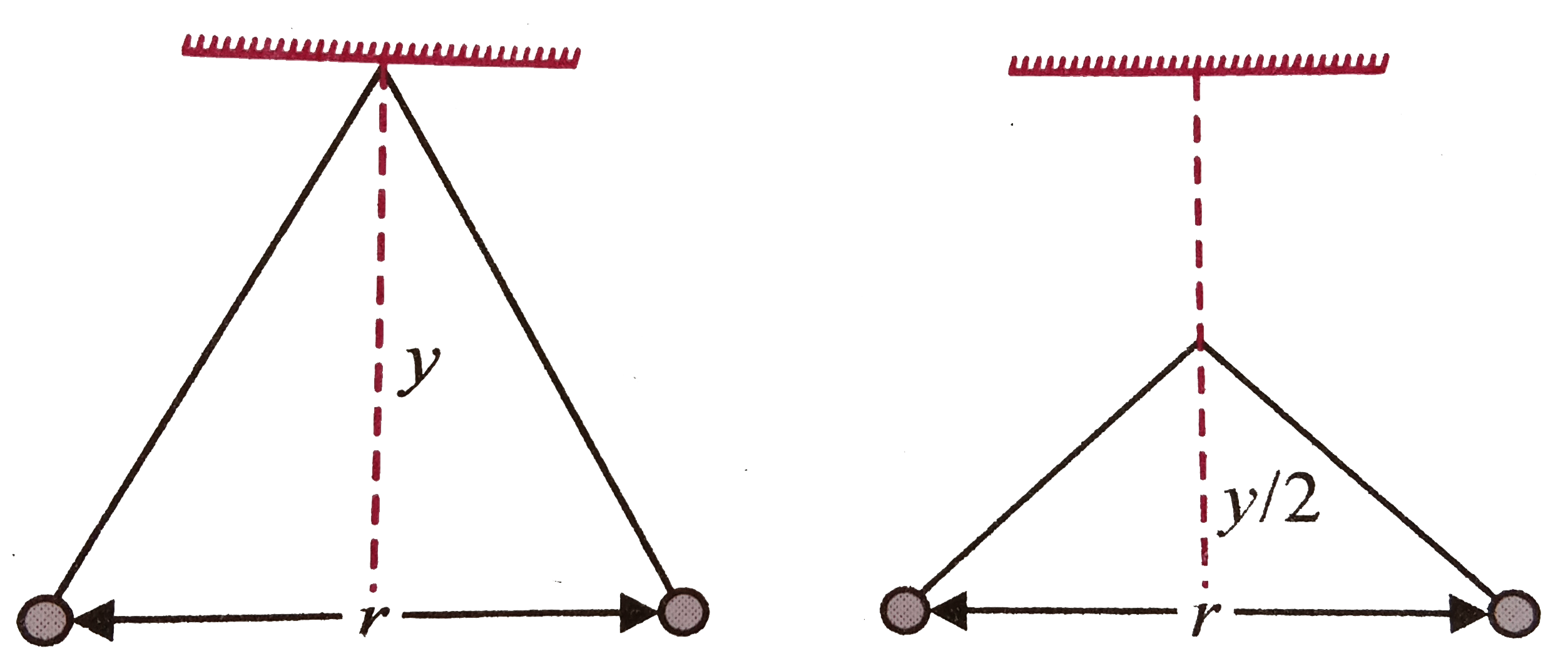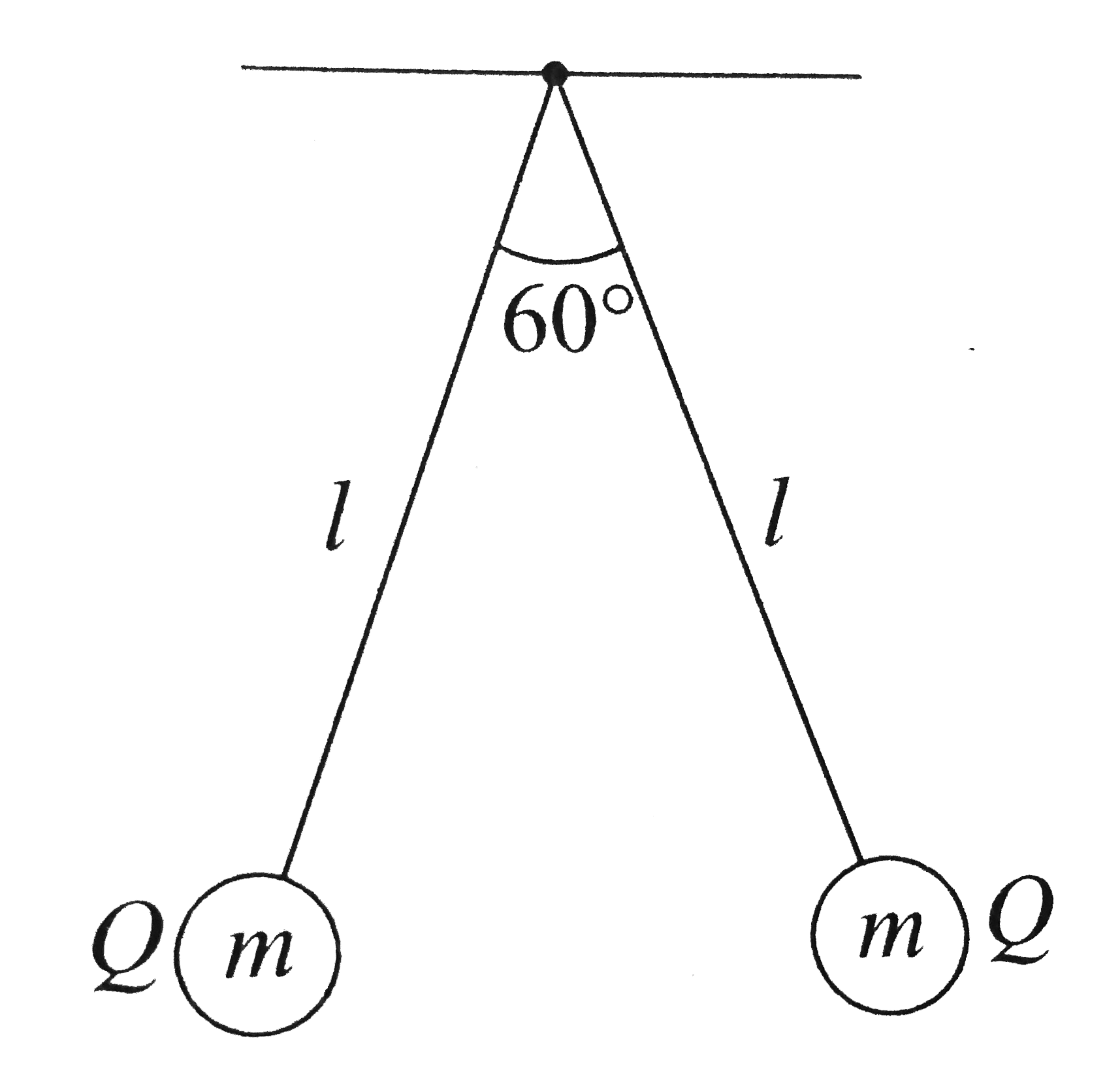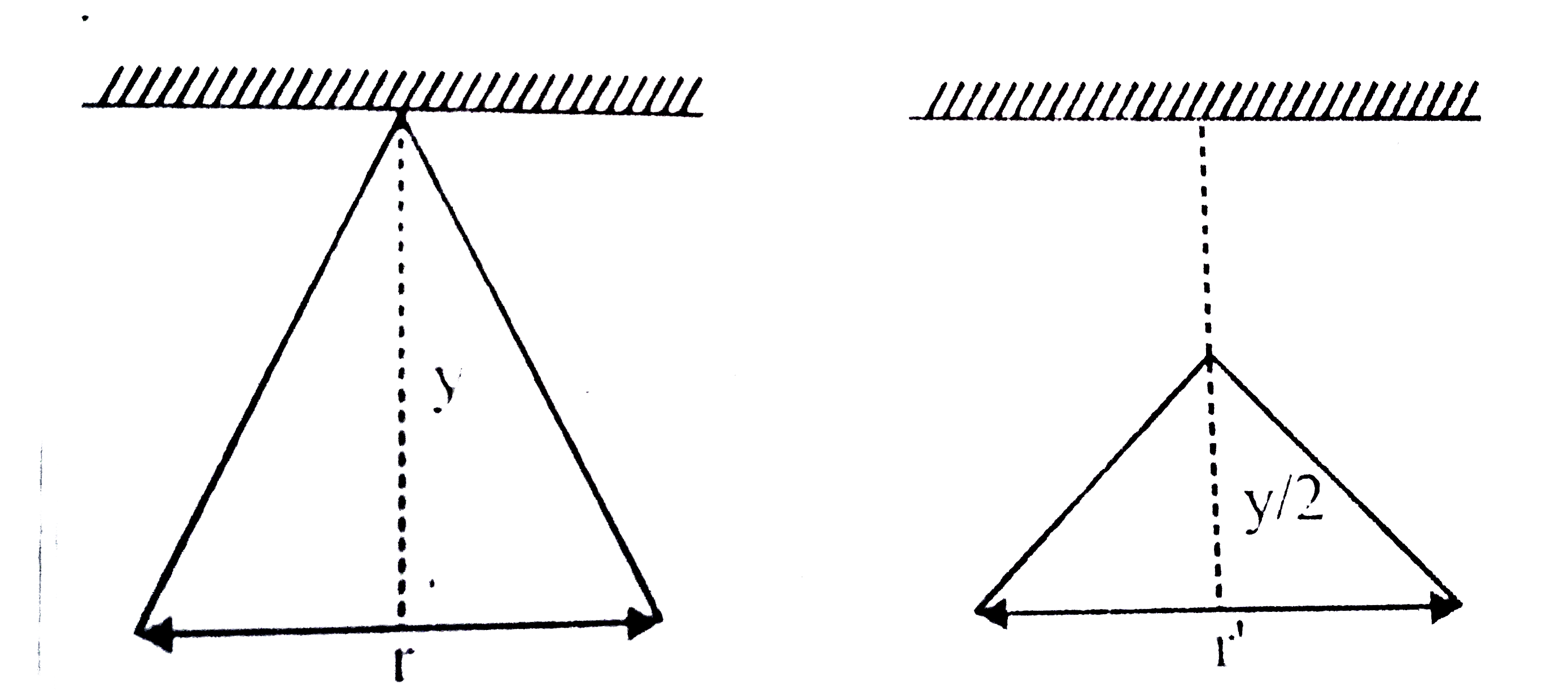Two identical balls , each having a charge q and mass m , are suspended from a common point by two insultating strings each of length L. The balls are held at a separation x and then released. Find
(a) the electric force on each ball
(b) the component of the resultant force on a ball along and perpendicular to string
(c ) the tension in the string
(d) the acceleration of one of the balls. Consider the situation only for the instant just after the release.
Let's solve the problem step by step.
Given:
- Charge on each ball: q
- Mass of each ball: m
- Length of the strings: L
- Separation between the balls: x
(a) Electric Force on Each Ball
The electric force Fe between two point charges is given by Coulomb's law:
Fe=14πϵ0⋅q2x2
(b) Components of the Resultant Force on a Ball
1. Weight of the ball: The weight W acts downward and is given by:
W=mg
2. Components of the weight:
- Along the string:
W∥=mgcosθ
- Perpendicular to the string:
W_{\perpendicular} = mg \sin \theta
3. Components of the electric force:
- Along the string:
Fe∥=Fecos(90∘−θ)=Fesinθ
- Perpendicular to the string:
F_{e\perpendicular} = F_e \sin(90^\circ - \theta) = F_e \cos \theta
4. Resultant force along the string:
Since there is no motion along the string, the tension T in the string balances the forces:
T=mgcosθ+Fesinθ
5. Resultant force perpendicular to the string:
The resultant force Fr acting perpendicular to the string is:
Fr=mgsinθ−Fecosθ
(c) Tension in the String
From the equilibrium of forces along the string, we have already derived:
T=mgcosθ+Fesinθ
(d) Acceleration of One of the Balls
Using Newton's second law, the net force acting on the ball in the perpendicular direction gives us:
Fr=ma
Substituting the expression for Fr:
mgsinθ−Fecosθ=ma
Thus, the acceleration a can be expressed as:
a=mgsinθ−Fecosθm
Summary of Results
1. Electric Force on Each Ball:
Fe=14πϵ0⋅q2x2
2. Components of Resultant Force:
- Along the string: T=mgcosθ+Fesinθ
- Perpendicular to the string: Fr=mgsinθ−Fecosθ
3. Tension in the String:
T=mgcosθ+Fesinθ
4. Acceleration of One of the Balls:
a=mgsinθ−Fecosθm
- Charge on each ball: q
- Mass of each ball: m
- Length of the strings: L
- Separation between the balls: x
The electric force Fe between two point charges is given by Coulomb's law:
1. Weight of the ball: The weight W acts downward and is given by:
W=mg
- Along the string:
W∥=mgcosθ
- Perpendicular to the string:
W_{\perpendicular} = mg \sin \theta
- Along the string:
Fe∥=Fecos(90∘−θ)=Fesinθ
- Perpendicular to the string:
F_{e\perpendicular} = F_e \sin(90^\circ - \theta) = F_e \cos \theta
Since there is no motion along the string, the tension T in the string balances the forces:
T=mgcosθ+Fesinθ
The resultant force Fr acting perpendicular to the string is:
Fr=mgsinθ−Fecosθ
From the equilibrium of forces along the string, we have already derived:
T=mgcosθ+Fesinθ
Using Newton's second law, the net force acting on the ball in the perpendicular direction gives us:
Fr=ma
Substituting the expression for Fr:
mgsinθ−Fecosθ=ma
Thus, the acceleration a can be expressed as:
a=mgsinθ−Fecosθm
1. Electric Force on Each Ball:
Fe=14πϵ0⋅q2x2
- Along the string: T=mgcosθ+Fesinθ
- Perpendicular to the string: Fr=mgsinθ−Fecosθ
T=mgcosθ+Fesinθ
a=mgsinθ−Fecosθm
Topper's Solved these Questions
- ELECTROSTATICSBOOK - DC PANDEY ENGLISHCHAPTER - ELECTROSTATICSEXERCISE - Example Type 5
5 Videos
- ELECTROSTATICSBOOK - DC PANDEY ENGLISHCHAPTER - ELECTROSTATICSEXERCISE - Example Type 6
4 Videos
- ELECTROSTATIC POTENTIAL AND CAPACITORSBOOK - DC PANDEY ENGLISHCHAPTER - ELECTROSTATIC POTENTIAL AND CAPACITORSEXERCISE - (C) Chapter exercises
50 Videos
- GRAVITATIONBOOK - DC PANDEY ENGLISHCHAPTER - GRAVITATIONEXERCISE - All Questions
135 Videos
Similar Questions
Two indentical balls, each having a charge of 2.00×10−7C and a mass of 100g , are suspended from a common point by two insulating strings each 50 cm long. The balls are held at a separation 5.0cm apart and then released. Find (a) the electric force on one of the charged balls (b) the components of the resultant force on it along and perpendicular to the string (c) the tension is the string (d) the acceleration of one of the balls. Answers are to be obtained just after the release.
View SolutionTwo identical pith balls, each carrying charge q, are suspended from a common point by two strings of equal length l. Find the mass of each ball if the angle between the strings is 2θ in equilibrium.
View SolutionTwo indentical pith balls, each carrying charge q, are suspended from a common point by two strings of equal length l. Find the mass of each ball if the angle between the strings is 2θ in equilibrium.
View SolutionTwo small spheres, each having a mass of 20 g, are suspended form a common point by two insulating strings of length 40 cm each. The spheres are identically charged and the speration between the balls at equilibrium is found to be 4 cm . Find the charge on each sphere.
View SolutionTwo path balls carrying equal charges are suspended from a common point by strings of equal length, the strings are rightly clamped at half the height. The equilibrium separation between the balls, now becomes :

View SolutionTwo identical balls each having a density ρ are suspended from as common point by two insulating strings of equal length. Both the balls have equal mass and charge. In equilibrium each string makes an angle θ with vertical. Now, both the balls are immersed in a liquid. As a result the angle θ does not change. The density of the liquid is σ. Find the dielectric constant of the liquid.
View SolutionTwo identical balls each having a density ρ are suspended from as common point by two insulating strings of equal length. Both the balls have equal mass and charge. In equilibrium each string makes an angle θ with vertical. Now, both the balls are immersed in a liquid. As a result the angle θ does not change. The density of the liquid is σ. Find the dielectric constant of the liquid.
View SolutionTwo small balls, each having equal positive charge Q are suspended by two insulationg strings of equal length l from a hook fixed to a stand. It mass of each ball =m and total angle between the two strings is 60∘m, then find the charge on each ball.

View SolutionTwo pitch balls carrying equal charges are suspended from a common point by strings of equal length, the equilibrium separation between them is r. Now the strings are rigidly clamped at half the height. The equilibrium separation between the balls now become

View SolutionTwo balls of radius r each are placed at a distance R and released . The speed of each ball when they collide

View Solution
